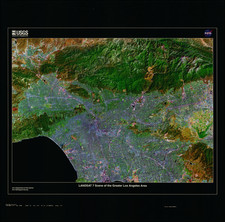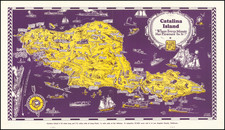19th Century Manuscript Map of "The First Jewish Site in Los Angeles"
Important early manuscript map of the Abila Tract at the north end of the intersection between College Street and Adobe, in what is now Chinatown and Stadium Way, near Chavez Ravine in Los Angeles.
The map is of special importance because of its detailed treatment of one of Los Angeles's earliest Jewish neighborhoods, and what is now designated as "the first Jewish site in Los Angeles", the "Hebrew Cemetery" shown in the middle of the survey.
A "Pest House" (quarantine building) neighbors the cemetery to the west. 13 lots are also covered by the survey, in total covering over 52 acres of land. The landowners of those lots include two early Los Angeles mayors.
The First Jewish site in Los Angeles was designated a California Historic Landmark (No.822) on Jan. 26, 1968.
History of the First Jewish Cemetery in Los Angeles
The first Jewish cemetery in Los Angeles was opened by the Hebrew Benevolent Society of Los Angeles in 1855. The Hebrew Benevolent Society was the first charitable organization in Los Angeles and was founded expressly for the purpose of "...procuring a piece of ground suitable for the purpose of burying ground for the deceased of their own faith, and also to appropriate a portion of their time and means to the holy cause of benevolence..." The Society received the deed for the land from the City Council on April 9, 1855.
Interestingly, shortly after establishing the cemetery, the Jewish community began looking for a way to move it to a different location. In the 1860s, petitions were put forward to exchange the cemetery plot for land elsewhere. These were unsuccessful, for reasons that remain unclear.
The present survey was modified in 1892, with several updates to the measurements, particularly around the cemetery. It was in 1902 that the expansion of the oil industry in the area caused environmental damage that necessitated the cemetery being moved elsewhere. The Congregation B'nai B'rith secured a new plot of land in present-day East Los Angeles, and the remains from the earlier cemetery were moved there. Today the Home of Peace Cemetery is the oldest operational Jewish cemetery in Los Angeles.
Biographies of the Landowners
The labeled lots are owned by B. Cohn, J. Bernard, Weisenberg, A. F. Coronel, and Prudent Beaudry. All of these figures were important in the early history of Los Angeles:
- B. Cohn is almost certainly Bernard Cohn (1835-1889), a wool buyer and businessman, as well as a member of the Los Angeles Common Council and Mayor Pro Tem. He had moved to Los Angeles from Prussia in 1857. Apparently, he maintained two families, one Jewish and one Catholic, on opposite sides of L.A.
- A.F. Coronel is Don Antonio Francisco Coronel (1817-1894) a Californio politician and ranchero who was Mayor of Los Angeles and California State Treasurer. Coronel was considered one of the first preservationists in Los Angeles, and his private collection formed the basis of the Natural History Museum of Los Angeles County. He is the namesake of Coronel Street, which is covered by the map.
- J. Bernard is Jean Bernard (? - 1889), was a wealthy Swiss-French businessman who was involved in brick manufacturing. He was the namesake for Bernard Street, which is covered by the map.
- Weisenberg was David Weisenberg (or Weissenberg). The LA Evening Express notes that he was delinquent on property taxes for this property or a contiguous parce in the November 23, 1878 edition. He is shown as owning a 1/4 share of 14 acres bounded in the north by the Abila Tract.
Prudent Beaudry (1819-1893) is probably the most famous of the landowners. He served as the 13th Mayor of Los Angeles, from 1874 to 1876, just before this map was made. He was very active in business ventures in and around Los Angeles. A number of accounts relate how in the 1860s he espoused anti-semitic views, saying that he planned to drive every Jew in Los Angeles out of business. By 1869, he had had a change of heart and was in business with Solomon Lazard having purchased the lease of the city's waterworks. Their company provided water for Los Angeles until 1899, when it was purchased by the Los Angeles Department of Water and Power. Lazard was apparently buried at the cemetery, though his grave was later relocated along with the others to what is now the Home of Peace Cemetery.
After his death, Los Angeles County praised Beaudry in these words:
Prudent Beaudry has the record of having made in different lines five large fortunes, four of which, through the act of God, or by the duplicity of man, in whom he had trusted, have been lost; but even then he was not discouraged, but faced the world, even at an advanced age, like a lion at bay, and his reward he now enjoys in the shape of a large and assured fortune. Of such stuff are the men who fill great places, and who develop and make a country. To such men we of this later day owe much of the beauty and comfort that surround us, and to such we should look with admiration as models upon which to form rules of action in trying times.
Pest House
The earliest mention of a pest house in Los Angeles newspapers appears in the Los Angeles Star, August 1, 1868. The writer acknowledges the outbreak of Small Pox in San Francisco and notes that the the Board of Health, in conjunction with County Board of Supervisors:
had established a Pest House outside the city proper and adopted a stringent resolution requiring the removal to this maison de sante of every case of variola. But the law did not work well. The relatives of stricken patients paid not attention to it, and to prevent the forceable removal of victims of the epidemic, a large majority of the cases were not reported to the Health Department at all The consquence was, that up to yesterday the public was not aware that the disease was so widespread.
The house was in regular use for small pox out breaks during the 1870s.









![[ Los Angeles, Santa Barbara, and Monterey ]. Plans on the Coast of California](https://storage.googleapis.com/raremaps/img/small/72683.jpg)

![The Map Plat Book Shows All Real Estate In and Around Pasadena [Map of Pasadena Including Street Index and What to see in Pasadena]](https://storage.googleapis.com/raremaps/img/small/91600.jpg)

![Pasadena [with] Southern California](https://storage.googleapis.com/raremaps/img/small/99025.jpg)
![[Los Angeles] Metro Greenline](https://storage.googleapis.com/raremaps/img/small/96817.jpg)